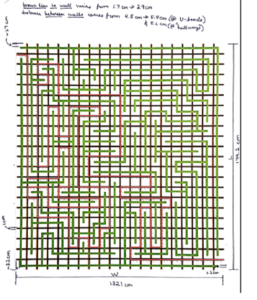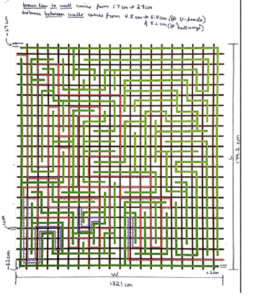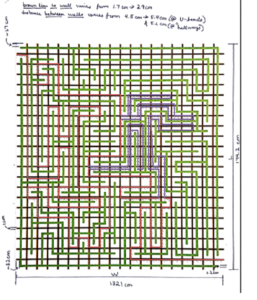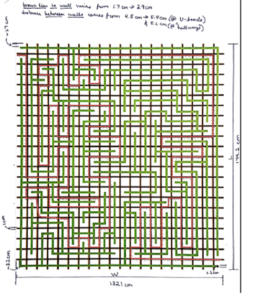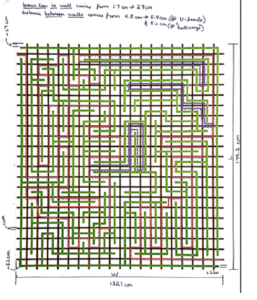Mission Duration at Maximum Speed
Descriptions, Calculations, and Images by Railan Oviedo (Manufacturing)
Description:
In order to calculate the mission duration, multiple paths were created and averaged in order to have a rough estimate on the time length. These paths were made intentionally long in distance so as to simulate worst-case scenario situations. Based on the given speeds of the robot*, the longest time to complete the average calculated path is 17.69 minutes (Goliath). Further calculations were made for the shortest possible path, and differences in time based on the average speed used by the robot (Either Half-Speed or One-Third Speed).
*P-Bot and ModWheels speeds were calculated assuming the motors are running are 5 V
Updated on 11/17/2017.
Methods of Calculation
First, the shortest path possible will be calculated in order to determine the best case scenario mission duration. Then, 6 long maze paths—which will start and end at the entrance and exit of the maze—will be created (4 of which will be off-shoots of the first 2) and their distance will be averaged in order to simulate any given run through the maze.
To calculate the time that a particular robot will take to navigate the averaged path, their provided speed will be reduced by a third—and another scenario with the speed reduced by a half—due to the fact that it will likely move slowly to maintain contact with the colored line. Furthermore, for every turn, an extra 2 seconds will be added to account for the action; and for every U-turn, an extra 6 seconds will be added to account for the action.
Robot Speeds:
All robot speeds besides Goliath are at no-load based off of calculations from the wheel diameter and the RPM of the robot’s given motor.
* These speeds assume a constant 5V supply to the motors, thus resulting in an RPm of 64
** Goliath’s speed is provided under their estimated weight conditions
Maze Calculations
Reference for Maze Dimensions by Zachary de Bruyn
One strip of brown is approximately 6.61 cm (132.1 cm/20 cm).*
*U-Turns will not be counted as a strip traveled and are only factored into the aformentioned 6 sec./U-Turn condition.
- Total Number of Turns: 12
- Time to be added: 12 * 2 sec. = 24 sec.
- Total brown strips covered: 52
- Linear distance: 52 * 6.61 cm = 343.72 cm = 3.4372 m.
- Total Number of Turns: 62
- Time to be Added: 62 * 2 sec. = 124 sec.
- Total brown strips covered: 170
- Linear Distance: 170 * 6.61 cm = 1,123.7 cm = 11.24 m.
- Total Number of Non U-Turns: 62 + 8 + 8 = 78; Total Number of U-Turns: 3
- Time to be Added due to Non U-Turns: 78 * 2 sec. = 156 sec.
- Time to be Added due to U-Turns: 3 * 6 sec. = 18 sec.
- Total brown strips covered: 170 + 28 + 10 + 6 = 214
- Linear Distance: 214 * 6.61 cm. = 1,414.54 cm = 14.15 m.
- Total Number of Non U-Turns: 62 + 14 + 8 + 12 = 96; Total Number of U-Turns: 5
- Time to be Added due to Non U-Turns: 96 * 2 sec. = 192 sec.
- Time to be Added due to U-Turns: 5 * 6 sec. = 30 sec.
- Total brown strips covered: 170 + 26 + 30 + 30 = 256
- Linear Distance: 256 * 6.61 cm. = 1,692.16 cm. = 16.92 m.
- Total Number of Turns: 80
- Time to be Added: 80 * 2 sec. = 160 sec.
- Total brown strips covered: 208
- Linear Distance: 208 * 6.61 cm. = 1,374.88 cm. = 13.75 m.
- Total Number of Non U-Turns: 80 + 2 + 10 + 8 = 100; Total Number of U-Turns: 3
- Time to be Added due to Non U-Turns: 100 * 2 sec. = 200 sec.
- Time to be Added due to U-Turns: 3 * 6 sec. = 18 sec.
- Total brown strips covered: 208 + 24 + 24 + 26 = 282
- Linear Distance: 282 * 6.61 cm. = 1,864.02 cm. = 18.64 m.
- Total Number of Non U-Turns: 80 + 8 + 6 + 4 = 98; Total Number of U-Turns: 3
- Time to be Added due to Non U-Turns: 98 * 2 sec. = 186 sec.
- Time to be Added due to U-Turns: 3 * 6 sec. = 18 sec.
- Total brown strips covered: 208 + 28 + 40 + 22 = 298
- Linear Distance: 298 * 6.61 cm. = 1,969.78 cm. = 19.70 m.
Results:
After calculating all the numerical values, the following tables have been compiled.
Final Notes
These estimations do not factor into account the time it would take to navigate a path that starts at a random point in the maze. However, since the created paths are incredibly large—in order to simulate a worst-case scenario—it is safe to assume that, in practice, the total time taken to navigate any given path will be less than the calculated values. This also assumes that the processes of turning or U-turning do not require considerably more amount of time to execute than originally assumed.




